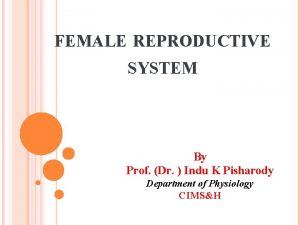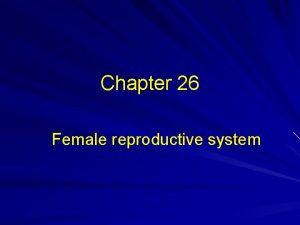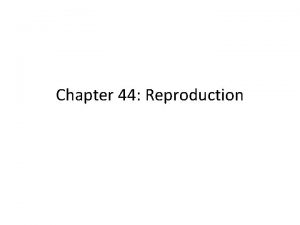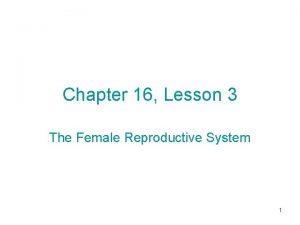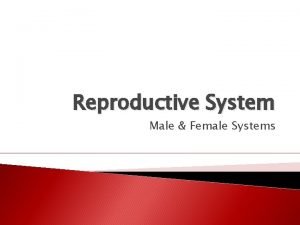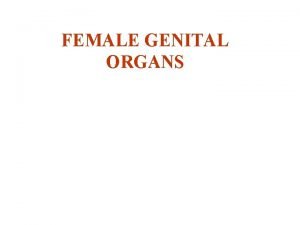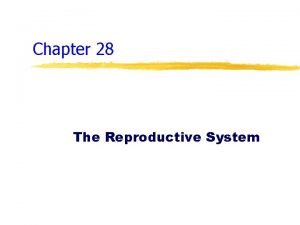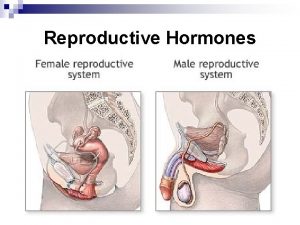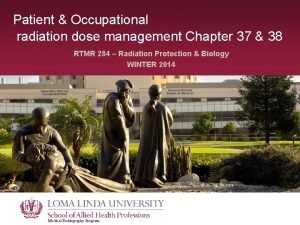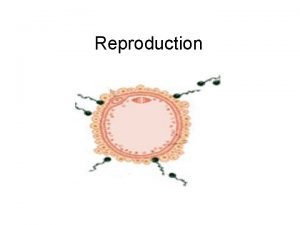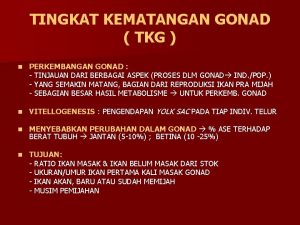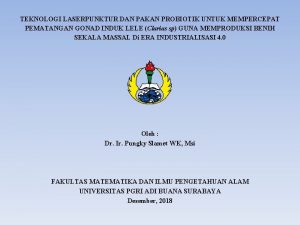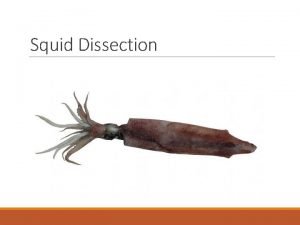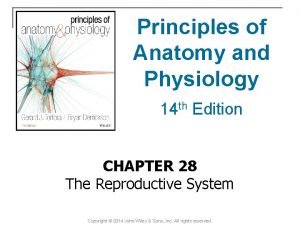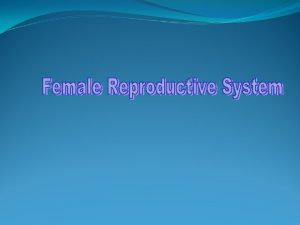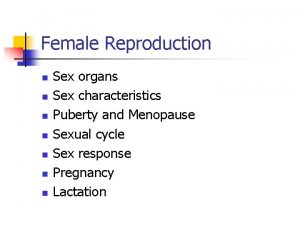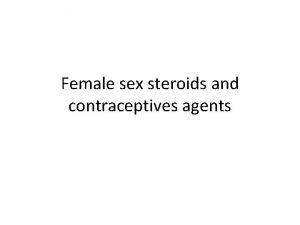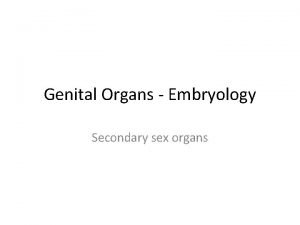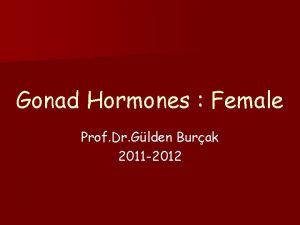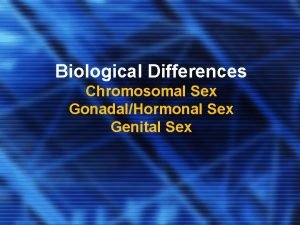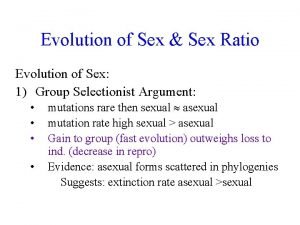Primary sex organs of the female Female gonad






























- Slides: 30


Primary sex organs of the female Female gonad In lower part of abdominal cavity About size of an almond Two functions: contain & produce ova Each ovary contains thousands of microscopic sacs called graafian follicles (the female gamete)

Graafian Follicle- female gamete �A single follicle matures every 28 days- an ovum matures inside – during reproductive years � Did you know a female will produce all of the oocytes she will ever have five months before she is born?

Reproductive ability begins at puberty-when menarche occurs (first menstrual period) When ovum is mature in the follicle, it is released (ovulation) about 2 weeks before menstrual period begins. After ovulation, the ovum travels down the fallopian tube Fertilization takes place in the fallopian tube usually within two days of ovulation

Following fertilization, the zygote implants in the uterus Development of follicle controlled by FSH, ovulation caused by LH Following ovulation, the remaining follicle turns yellow and becomes the corpus luteum, which secretes progesterone If the egg is fertilized, progesterone continues If the egg is not fertilized, corpus luteum degenerates and progesterone production stops

ALSO called OVIDUCTS 4” long-not attached to ovaries Pregnancy that implants in tube. Ectopic Pregnancy Smooth muscle and cilia help propel ova into the uterus

Hollow, thick-walled, pear shaped, highly muscular organ Lies behind the urinary bladder and in front of the rectum Fundus- bulging upper part of the uterus, the body is the middle portion, and the cervix is the narrow portion that extends into the vagina Uterine wall- 3 layers, outer layer is the visceral peritoneum, thick muscle layer is the myometrium, and the mucous lining is the endometrium

Uterus- hollow, Thick walled, peared shaped, muscular organ. 3 parts: perimetrium myometrium Perimetrium (visceral peritoneum) Myometrium Endometrium endometrium

What instrument is used to observe the cervix? SPECULUM Cervix The cervix is the lower narrow end that extends into the uterus

Smooth muscle with a mucous membrane lining Hymen- membrane found near the entrance to the vagina Approx. 10 cm long Hymen External opening of the vagina may be covered by a perforated membrane

Vulva- external organs of reproduction Mons pubis- pad of fat that overlies pubic bone Clitoris- small structure above the urinary meatus that contains many nerve endings Labia majoria- folds of skin (fat deposits) that surround the entrance to the vagina Perineum- area between vagina and rectum Episiotomy- incision in perineum to make more room for childbirth

Accessory organs Areola- darkened area that surrounds the nipple Prolactin stimulates the mammary glands to secrete milk following childbirth

Menstrual Cycle Occurs every 28 days Divided into 4 stages Follicle stage- FSH from pituitary » ovary, stimulates follicle with ovum to mature» releases estrogen and prepares uterine lining, lasts 10 days Ovulation stage- 3 different hormones circulating in the females bloodstream estrogen, LH, FSH Luteal stage- corpus luteum secretes progesterone. If ovum fertilized, corpus luteum continues secrete progesterone, which prevents further ovulation and maintains uterine lining, lasts 14 days Menstruation stage- if no embryo, corpus luteum dissolves» unfertilized ovum and uterine lining breaks down and is discharged, 3 -6 days.

Menstral Cycle Amenorrhea- absence of menstruation Normal for pregnant women Can be cause of hormonal imbalance PMS ) pre-menstrual syndrome) Symptoms prior to menstrual cycle Symps: irritability, nervousness, mood swings, weight gain Tx: medication & diet Dysmenorrhea-painful menstruation

Monthly menstrual cycle comes to an end Approximately age 45 -50 Symptoms include: 1. Hot flashes 2. Dizziness and headaches 3. Emotional changes Oophorectomy will cause premature menopause

Reproductive process: conception & contraception Conception is the sperm reaching the egg Contraception may use several options Most use estrogen and progesterone hormones Artificial insemination- semen is place into vaginal canal, usually around time of ovulation In-Vitro Fertilization- female given ovulation inducing drugs, once ova matures it is removed from the follicle and cultured with the sperm in a lab then gets placed into the uterus

Conception and Pregnancy Germ cells (gametes)- produced by Gonads Female gonad=ovary Female gamete=ova Male gonad=testes Male gamete=sperm


Normal cell division is mitosis In the formation of germ cell, special process of cell division occurs – called Meiosis Female meiosis is oogenesis Male meiosis is spermatogenesis Female gametes have 22 pairs of autosomes and single pair of sex chromosomes – XX Male gametes have 22 pairs of autosomes and a single pair of sex chromosomes - XY

Fertilization During sexual intercourse (coitus) sperm enter female reproductive tract and live or a day or two Approximately 100 million sperm in 1 cc of semen- if count less than 20 million, man is sterile

Eventually, one sperm penetrates and fertilizes the ovum True fertilization occurs when the sperm nucleus combines with the ovum nucleus to form a fertilized egg cell- zygote The zygote has 46 chromosomes It divides, and those cells divide, and so on

Zygote continues to divide as it travels down fallopian tube and is implanted in wall of uterus. At 7 days, the zygote becomes an embryo At three months, it becomes a fetus

Pregnancy=prenatal period or gestation Normal pregnancy= 40 weeks or 280 days also divided into 3 trimesters (3 month periods) Quickening=first recognizable movement of fetus between 4 th and 5 th month Parturition- the act of giving birth Spontaneous abortion= miscarriage Induced abortion: the termination of pregnancy by artificial means



Labor Dilation stage • The uterine smooth muscle begins to contract • Contractions move the fetus down the uterus and cause the cervix to dilate • The cervix is completely dilated at 10 centimeters

Placental stage • The last stage of labor • Also known as afterbirth • Delivered due to final uterine contractions

What is an episiotomy? Why might it be necessary Expulsion stage The baby is actually delivered • Natural • Cesarean

Ectopic pregnancy • What does ectopic mean? occurring in an abnormal position or place; displaced What are some symptoms of ectopic pregnancy? • Abdominal or pelvic pain and light vaginal bleeding are often the first warning signs of an ectopic pregnancy What is the most common treatment option? • laparoscopic surgery What are the risk factors? • Previous ectopic pregnancy • Structural concerns • Inflammation/infection –STD • Fertility issues • Contraception choice

Postpartum depression New mothers often feel restless, anxious, fatigued and worthless Some new moms worry they will hurt themselves or their babies Unlike the "baby blues, " postpartum depression does not go away quickly What causes this condition?
 What is gonad
What is gonad Xxtesticles
Xxtesticles Sex sex sex
Sex sex sex Sex sex sex
Sex sex sex Secondary sexual characters
Secondary sexual characters Sex in the greenhouse
Sex in the greenhouse Female organs
Female organs Infindibulum
Infindibulum Female organs
Female organs Left lower quadrant organs
Left lower quadrant organs Chapter 16 the reproductive system answer key
Chapter 16 the reproductive system answer key Female organs
Female organs Function of fallopian tube
Function of fallopian tube Female hymen
Female hymen Sex rat
Sex rat X linked recessive punnett square
X linked recessive punnett square Sex determination and sex linkage
Sex determination and sex linkage Once a sex offender always a sex offender
Once a sex offender always a sex offender Posterior abdominal wall
Posterior abdominal wall Primary and secondary retroperitoneal organs
Primary and secondary retroperitoneal organs Male gonad
Male gonad Gonad shielding
Gonad shielding Male gonad
Male gonad Gonadlar cinsiyet bezleri
Gonadlar cinsiyet bezleri Sinonim kematangan
Sinonim kematangan Mempercepat pematangan gonad lele
Mempercepat pematangan gonad lele Squid gonad
Squid gonad Testicular function
Testicular function Female external reproductive system
Female external reproductive system Female sex organ
Female sex organ Function of uterine cavity
Function of uterine cavity






